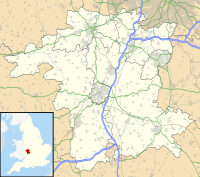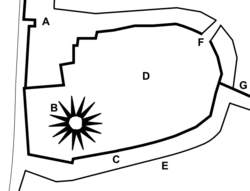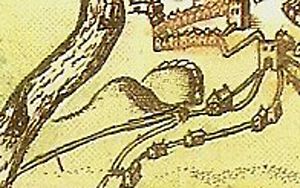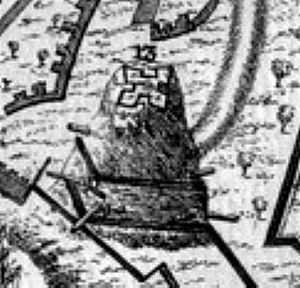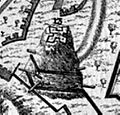Worcester Castle facts for kids
Quick facts for kids Worcester Castle |
|
|---|---|
| Worcester, Worcestershire, England | |
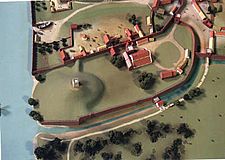
A picture showing what Worcester Castle might have looked like in 1250 AD
|
|
| Coordinates | 52°11′12″N 2°13′20″W / 52.1867°N 2.2223°W |
| Type | Motte and bailey |
| Site information | |
| Condition | Demolished |
Worcester Castle was a strong fort built by the Normans in England. It was constructed between 1068 and 1069 in Worcester, England. Urse d'Abetot built it for William the Conqueror, who was the King of England.
The castle had a special design called a motte-and-bailey. This meant it had a large mound (the motte) with a tower on top, and a walled area below (the bailey). It was located on the south side of the old Anglo-Saxon city. Part of the castle even cut into the land of Worcester Cathedral.
Royal castles belonged to the king. They were looked after by a special person called a constable. At Worcester, this job was passed down through the Beauchamp family. This gave them a lot of power in the city. The castle was important in many wars during the 1100s and early 1200s. These included a civil war called the Anarchy and the First Barons' War.
In 1217, King Henry III's government decided to reduce the Beauchamp family's power. They also wanted to make the castle less of a military threat. So, they gave a big part of the castle's bailey back to the cathedral. Without its full bailey, the castle was not as useful for fighting. It did play a small part in the Second Barons' War in the 1260s.
A prison was built at the castle by the early 1200s. Worcester Castle continued to be used as the county prison until the 1800s. Then, a new prison was built in Worcester. The old castle site was completely changed. Today, almost nothing is left of Worcester Castle. Only Edgar's Tower, a gatehouse for the cathedral, remains. It was built where the castle's entrance used to be.
Contents
History of Worcester Castle
Building the Castle: 1000s
Worcester Castle was built after the Norman conquest of England. This happened when the Normans took control of England. The castle was built in the Anglo-Saxon city of Worcester between 1068 and 1069. King William the Conqueror ordered many castles to be built in important towns across England. Worcester Castle was one of them.
The first castle was made of wood. It had a motte-and-bailey design. There was a bailey (a walled area) to the north and south of the motte (the mound). The top of the motte was about 18 feet (5.5 meters) wide. The castle was in a good defensive spot on the east bank of the River Severn. It was in the south-west corner of the town. It used the old town walls and ditches for protection. Urse d'Abetot was put in charge as the local sheriff and the constable of the new castle.
Worcester was a castle built inside an existing town. Many such castles needed old buildings to be cleared away. But at Worcester Castle, the ditch for the outer bailey cut through part of Worcester Cathedral's cemetery. It's not clear if the cemetery was still being used. But this upset Ealdred, the Archbishop of York. He had a lot of interest in Worcester. He complained about the land being taken. He even formally cursed Urse for it.
Wars and Changes: 1100s–1200s
Worcester remained a royal castle, owned by the king. But after a few years, the jobs of sheriff and constable became hereditary. This meant they were passed down in the Beauchamp family. They were the people who took over from Urse d'Abetot. Urse's son, Roger, got the jobs first. Then Walter de Beauchamp, who married Urse's daughter, took over. After him came William de Beauchamp. The Beauchamps ran the castle almost like it was their own. Even though they controlled Worcester, the Beauchamps usually lived at Elmley Castle, which was about 12 miles (20 km) away.
In 1113, Welsh raiders attacked Worcester. They broke into the outer bailey of the castle and set fire to the buildings. The wooden castle was destroyed. It had to be rebuilt, again using wood.
In the late 1130s, a civil war started in England. It was called the Anarchy. King Stephen and the Empress Matilda fought for control of the kingdom. Worcestershire became an important place for battles. The first attack on Worcester happened in late 1139. An army from Gloucestershire attacked the city. They tried to take the castle. Then they entered the city from the north, stealing things and burning buildings. Because of this, Walter de Beauchamp decided to support Matilda.
Worcester became a base for King Stephen's forces for a while. Stephen replaced Walter as constable with Waleron de Beaumont. But then the city and castle were taken back for the Empress by Robert of Gloucester. In response, Stephen attacked and burned the city in 1148. He attacked it again in 1150, shortly before the war ended. Stephen built two small castles nearby to help him attack Worcester Castle. One was at Henwick Hill and the other at Red Hill. After the war, Henry II, the Empress's son, finally confirmed Walter as the constable of Worcester Castle.
By the end of the 1200s, William de Beauchamp, Walter de Beauchamp's grandson, was in charge of the castle for the king. In the 1100s, many castles in England were being changed from wood to stone. In 1204, King John ordered the sheriff of Worcester to rebuild the gatehouse. He wanted it changed from wood to "good and fine stone." This work cost money. There were other repairs too, like fixing internal buildings and stables.
Another civil war started in England in 1215. This was between King John and rebel barons. Prince Louis of France also supported the rebels. King John took control of the castle in 1214. But William de Beauchamp sided with the rebels in 1216. King John sent his forces to attack the castle and successfully took it back. Even after John died, the war continued. Forces loyal to John's young son, Henry III, finally won against the rebels in 1217.
The old argument about the cathedral graveyard continued. In 1217, King Henry III's government decided to give the disputed land to the cathedral. A group met to decide how to divide the land. They decided the division should go right through the bailey. The far side was given back to the cathedral. This made the rest of the castle not useful for military purposes. By doing this, Henry made the church happy. He also broke the Beauchamps' power in the city by weakening their local fort.
The castle was still used for a while. This was partly because the Worcestershire county prison was located in the outer bailey. The first mention of this prison is from 1221. A porter was recorded as working there as a prison guard. The prison was likely made of wood during the Middle Ages. Prisoners often escaped. Some escapes were recorded in the 1220s. During the Second Barons' War, Worcester was captured, and all the prisoners were set free. Later in the same war, King Henry III was held prisoner there for a time by Simon de Montfort. The castle was also used for the Worcestershire county court. Local officials were elected there too.
Later Years and Demolition: 1300s–1800s
The sheriffs of Worcestershire continued to control the castle as constables. The property was passed down from the Beauchamps to the Earls of Warwick. This continued until Richard Neville, known as the "Kingmaker," died in 1471. He died during the Wars of the Roses. The winning king, Edward IV, divided up Neville's lands. He gave the castle to his son. This ended the connection between Worcester and the Earls of Warwick. The last constables were appointed in the 1540s. After that, no more constables were put in charge.
The castle's walls were used as a source of stone for other buildings. The motte was used to keep animals on. Only the sheriff's county prison remained. The historian John Leland wrote in the 1540s that the castle was "now clean down," meaning completely destroyed. He noted that the motte was still very large but covered in plants. A gatehouse called Edgar's Tower was built by the cathedral. It was built where the old castle gatehouse used to be. It controlled who could enter the former bailey.
In 1628, the castle site was given by the Crown to Giles Clutterbuck. But the local important people complained. This led to a legal case, and the county successfully got the site back. In 1642, England entered a civil war. This was between King Charles I's supporters (Royalists) and the supporters of Parliament. Worcester's city walls were made stronger. A sconce, which is a small fort, was built on top of the motte of Worcester Castle.
The castle continued to be used as the county prison after the war. In 1653, a new prison, made of stone and brick, was built on the castle grounds. In the 1770s, a prison reformer named John Howard visited the prison. He was very critical of it. He especially complained about the castle's underground dungeon. You had to go down 26 steps to reach it. The room was round, 18 feet (5.5 meters) across, and had an iron grill.
Worcester made many changes after Howard's report. By 1788, the prison had 18 new cells for men and two for women. It also had the dungeon and sick-rooms. However, it was holding 74 prisoners when Howard visited. Two prisoners often shared each cell, sleeping together on the floor. Like other prisons at the time, Worcester Castle was run by a private person. A local butcher was paid to run it. The prison was known to have outbreaks of "gaol fever," which was a disease. It even caused the death of a local doctor who visited the prison.
A new county prison was built in 1814. It had a more modern design with wings spreading out. This new prison was built on the north side of Worcester. The street there was named "Castle Street" because of it. The Dean and Chapter of Worcester Cathedral bought the old prison in 1823. The outer bailey of the castle became known as the College Green. You could get to College Green through Edgar's Tower. The motte was slowly taken down between 1823 and 1846.
Images for kids


